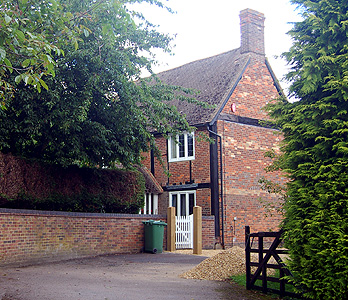Moor End Farmhouse Eaton Bray

Moor End Farmhouse July 2012
Moor End Farmhouse is, today, hidden behind modern development in the High Street. It was listed by the former Department of Environment in September 1980 as Grade II, of special interest. The department dated the building to the 17th century “with later additions”. The front wing s timber framed with brick infill panels. The rear wing is in brick with clunch ashlar. The linking wing is of similar construction. The house comprises two storeys and attics beneath a modern tiled roof.
The farm was part of the Manor of Eaton Bray which, by the late 19th century was in the hands of the Macnamara family. In 1881 the tenants were Charles and John Hedges [BML6/11/1viii]. By 1897 the tenant was William Bates [BML6/6/1(viii)]. He was dead by 1903 because Kelly’s Directory for that year, as for 1906, lists the tenant as the executors of William Bates. The Pedley Settled Estates were pt up for auction in 1915 by Arthur Macnamara's executors. The sale particulars for Moor End Farm [Z153/2] read as follows:
LOT 20
A Compact Freehold Agricultural Holding
of about
122a. 2r. 13p.
comprising
Moor End Farm
including
A Brick and Half-timbered House
of two stories, with tiled roof and Porch Entrance, with Drive Approach from the high road, near to the Village Schools and containing: ON THE UPPER FLOOR - Four Bed Rooms. ON THE GROUND FLOOR - Two Sitting Rooms, Kitchen, Scullery, Wash-house, two Pantries and Dairy, with Garden.
Farm Premises
adjoining, timber-built and thatched and tiled, of Two Barns, Cow House, Stabling, Corn Store, cattle Sheds, Open Waggon [sic] Shed, Piggery and Fold and Rickyards together with the several Enclosures of
Pasture and Arable Land
The land comprised: 9 acres, 32 poles of pasture; 2 roods of garden; a pond of 28 poles; 105 acres, 2 roods, 8 poles of arable with the remaining area being buildings, "Green Baulk", and "Sheep Wash". Bedfordshire County Council leased the garden for £1 per annum and the remainder was leased by Fred Bates for £183/10/- per annum. "This Lot is Sold subject to the right of the Parishioners of Eaton Bray to use the Sheep Wash".
The Lot was withdrawn. Fred Bates is given as occupier in Kelly’s Directory for 1910, 1914, 1920 and 1924. In 1917 and 1918 the farm was compulsorily hired by Bedfordshire County Council [BML10/22/48]. This was because the U-Boat campaign by Germany was taking such a toll on British shipping that it was feared that the country might be starved into surrender. As a panic measure the government instructed County Agricultural Executive Committees to order farmers to break up meadow and pasture to plant arable crops which is what happened in this case. Naturally most of these crops failed or brought in small yields but the introduction of the convoy system by the Admiralty saw the end of the U-Boat menace.
The Rating and Valuation Act 1925 specified that every building and piece of land in the country was to be assessed to determine its rateable value. Eaton Bray, like most of the county, was assessed in 1927 and the valuer visiting Moor End Farm [DV1/H30/8] found that it was owned by the executors of W. H. Wallace, he had presumably bought the Farm from the Pedley Estates. His tenant, Fred Bates had paid rent of £202 per annum since 1906, though this is annotated “now £101/10 fixed in 1916” presumably the date at which Wallace bought it.
The reason for the dramatic decline in rent was that the former 122 acres had been reduced to 52. The valuer commented: “Nice house, very good Homestead”. Kelly’s Directory for 1928, 1931, 1936 and, the last directory for the county, 1940, all give the tenant as Thomas Gurney. In 1944 the arable land was sold following the death of Mrs. Wallace [BML10/22/64].